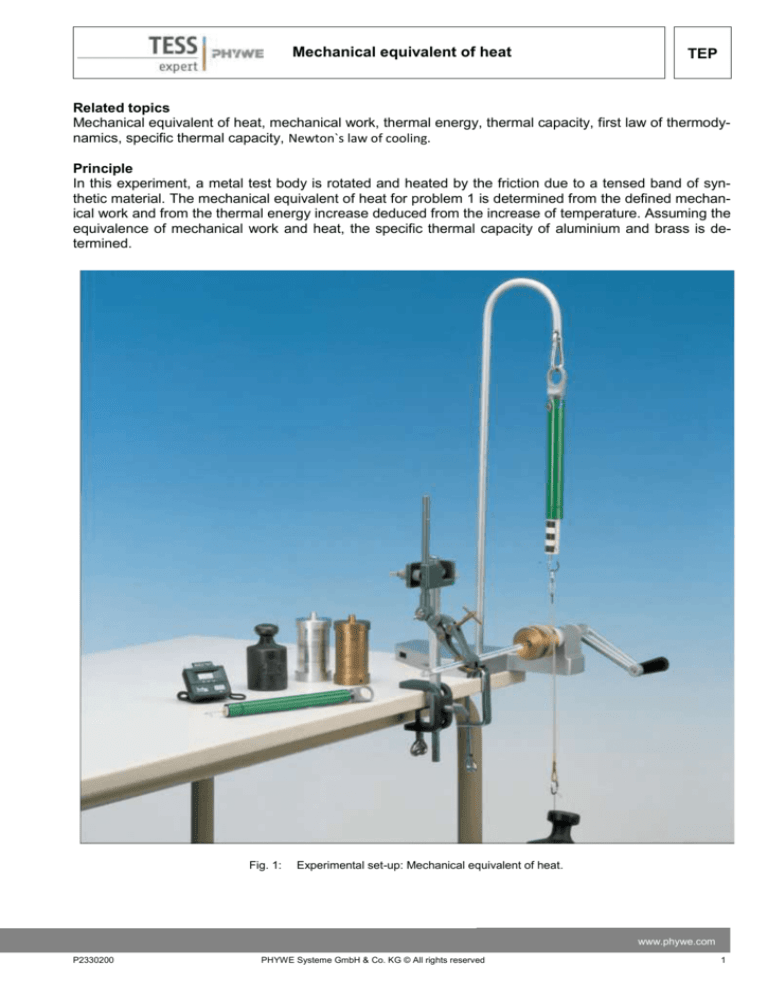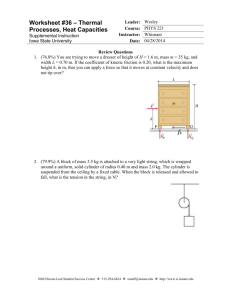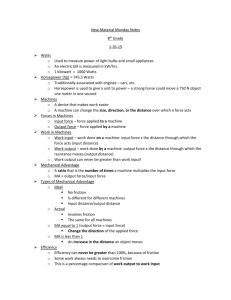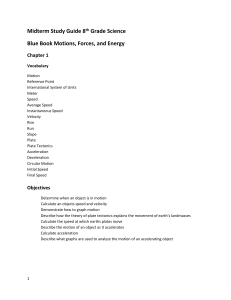
Mechanical equivalent of heat
TEP
Related topics
Mechanical equivalent of heat, mechanical work, thermal energy, thermal capacity, first law of thermodynamics, specific thermal capacity, Newton`s law of cooling.
Principle
In this experiment, a metal test body is rotated and heated by the friction due to a tensed band of synthetic material. The mechanical equivalent of heat for problem 1 is determined from the defined mechanical work and from the thermal energy increase deduced from the increase of temperature. Assuming the
equivalence of mechanical work and heat, the specific thermal capacity of aluminium and brass is determined.
Fig. 1:
Experimental set-up: Mechanical equivalent of heat.
www.phywe.com
P2330200
PHYWE Systeme GmbH & Co. KG © All rights reserved
1
TEP
Mechanical equivalent of heat
Equipment
1
1
1
1
1
1
1
1
1
1
1
1
1
Mechanical equiv. of heat app.
Friction cylinder Al
Friction cylinder CuZn
Commercial weight, 1000 g
Commercial weight, 2000 g
Support rod PHYWE,square,l = 250 mm
Right angle clamp PHYWE
Bench clamp PHYWE
Universal clamp with joint
Spring balance 10 N
Spring balance 100 N
Stopwatch, 1/100 sec.
Universal balance, 5.300 g / 1 g
04440-00
04441-03
04441-02
44096-70
44096-78
02025-55
02040-55
02010-00
37716-00
03060-03
03060-04
03071-01
46007-00
Tasks
1. Determination of the mechanical equivalent of heat.
2. Determination of the specific thermal capacity of aluminium and brass.
Set-up and procedure
The experimental set-up is shown in Fig. 1. To start with, the friction cylinder and the crank handle are fixed to the rotating bearing and the base
plate is clamped very firmly to the table with the screw clamps. Failure to
do so may cause tilting of the base plate during cranking, which in turn
may cause the thermometer introduced into the bore hole to break. The
friction band fastened to the dynamometer is laid 2.5 times around the friction cylinder (so that the dynamometer is relieved when the crank is
turned clockwise). The 2 𝑘𝑔 weight is attached to the lower end of the friction band. To measure temperature, the thermometer is held with a universal clamp and carefully introduced into the bore hole of the friction cylinder. The thermometer and the bore hole of the cylinder must be carefully
aligned, so the thermometer will not be damaged while the cylinder is rotating. To improve thermal contact, the bore hole is filled with heat conducting paste. Weigh the friction cylinders at the beginning of the experiment.
At the beginning of the measurement, temperature is recorded every thirty
seconds during four minutes. After this, the crank handle is turned a certain number of times (e. g. 200 times) as fast and regularly as possible.
Simultaneously, the force 𝐹𝐷 acting on the suspension is determined with
the dynamometer. Subsequently, the continuous temperature decrease is
noted at intervals of thirty seconds.
The second part of the experiment is carried out similarly, in order to
measure the thermal capacity of an aluminium cylinder and that of a brass
cylinder whose mass is double the mass of the aluminium cylinder. Before
starting the experiment, the friction cylinder and the friction band should
be wiped with a dry cloth to rid them from metallic abrasion dust. When
using the aluminium cylinder, friction should not exceed 10 𝑁, (for this, the
1 𝑘𝑔 weight is used), in order to avoid severe abrasion and soiling of the
friction band. The specific thermal capacity of the cylinder is calculated
from the number of crank rotations n, the mean force at the dynamometer Fig. 2: Equilibrium of forces
when the friction cylin𝐹𝐷 and the increase of temperature 𝑇.
der is rotated.
2
PHYWE Systeme GmbH & Co. KG © All rights reserved
P2330200
Mechanical equivalent of heat
TEP
Theory and evaluation
For a long time it was debated as to whether the heat of a system, which used to be defined in terms of
its temperature, was a form of energy or an independent magnitude which is conserved. During the first
half of the nineteenth century, it was proven that mechanical energy due to friction is completely converted to heat, independently of the course of the transformation process and of the physical and chemical characteristics of the material used. Heat was accordingly defined as the energy of disorganized,
macroscopically invisible molecular movements.
The quotient between realized mechanical work 𝑊 and the quantity of heat 𝑄 generated through friction is called the mechanical equivalent of heat. In this experiment, mechanical work is performed by rotating the friction cylinder against the sliding frictional force 𝐹𝑅 of the synthetic friction band. As weight 𝑀
(cf. Fig. 2) is not accelerated when the crank is rotated, weight 𝐹𝐺 = 𝑀𝑔 = 49 𝑁 (𝑀: mass of the
weight, 𝑔: terrestrial gravitational acceleration) on one side and the sliding frictional force 𝐹𝑅 acting together with force 𝐹𝐷 on the suspension of the dynamometer on the other side, must cancel each
other:
𝐹𝑅 = 𝐹𝐺 – 𝐹𝐷
(1)
Friction work W is thus determined from the friction path of 2 𝑟 𝑛 (𝑟: radius of the cylinder, 𝑛: number of
turns) and is found to be:
𝑊 = 2 𝑟 𝑛 𝐹𝑅 = 2 𝑟 𝑛 (𝐹𝐺 – 𝐹𝐷 )
(2)
Whilst the synthetic band slides over the cylinder, a large portion of mechanical work is converted to
thermal energy 𝑄 through inelastic deformations of the friction material. Accordingly, the temperature 𝑇
of the friction cylinder increases by a temperature difference 𝑇 :
𝑄 = 𝐶𝑡𝑜𝑡 • 𝑇
(3)
𝐶𝑡𝑜𝑡 is the total thermal capacity of the heated parts. It is the sum of the thermal capacity 𝐶𝑐𝑦𝑙 of the friction cylinder (𝑚: mass, specific thermal capacity (CuZn: 𝑐 = 0.385 𝐽/𝑔𝐾)):
𝐶𝑐𝑦𝑙 = 𝑐 • 𝑚
(4)
Of the thermal capacity of the friction band (𝐶𝑏𝑎𝑛𝑑 = 4 𝐽/𝐾) and of the thermal capacity of the thermometer (𝐶𝑡ℎ = 4 𝐽/𝐾). If the mass of the friction cylinder is 𝑚 = 640 𝑔, total thermal capacity amounts to:
𝐶𝑡𝑜𝑡 = 𝐶𝑐𝑦𝑙 + 𝐶𝑏𝑎𝑛𝑑 + 𝐶𝑡ℎ = 254 𝐽/𝐾
(5)
The thermal capacities of the insulated bearing and of the heat conducting paste were neglected. Fig. 3
displays a temperature-time diagram for an example of measurement. The shape of the graph makes it
clear, that thermal energy is continuously given off to the environment while the crank is being turned.
Hence, temperature difference 𝑇 is determined as is generally done for the determination of specific
heat: momentary temperature compensation is extrapolated through prolongation of both straight graph
branches. If a parallel line to the temperature axis is drawn in such a way that two equal surfaces 𝐴1 and
𝐴2 are formed, the difference of the ordinates of the points of intersection of the two straight lines is the
temperature difference 𝑇 sought after.
The cylinder is cooled mainly due to convection. In this case we can use the Newton`s law of cooling as a good
approximation: “The rate of heat loss of a body is proportional to the difference in temperatures between the
body and its surroundings”.
www.phywe.com
P2330200
PHYWE Systeme GmbH & Co. KG © All rights reserved
3
TEP
Mechanical equivalent of heat
In this approximation the temperature difference in Fig. 3 corresponds to the heat loss rate (first derivative of total heat amount). The integral of temperature difference thus equals to the total amount of lost heat, which
graphically corresponds to the area confined under the temperature curve in Fig. 3.
There are two curves in Fig. 3. The first one (real experiment) corresponds to the mechanical work slowly transferred into heat. The second curve (imaginary experiment) shows instantaneous transfer. In both experiments the
cylinder has the same amount of heat in the beginning of the experiment and after heating due to friction. Mechanical work is the same for both curves. Thus the amount of lost heat (area under curves) due to convection
must be the same for both curves. This is possible only if A1 = A2, which uniquely defines the position of the vertical line (instantaneous process) in Fig. 3.
Exponential cooling process can be approximated with straight lines for short time intervals.
In the case of a measurement example where the residual load on the dynamometer is 𝐹𝐷 = 3 𝑁, work
Fig 3: Temperature-time diagram for a measurement example.
4
PHYWE Systeme GmbH & Co. KG © All rights reserved
P2330200
Mechanical equivalent of heat
TEP
after 200 rotations of the friction cylinder amounts to:
𝑊 = 1301 𝐽;
According to equation (3), the resulting temperature increase of the friction cylinder, 𝑇 = 5.1 𝐾, produces the following amount of thermal energy:
𝑄 = 1296 𝐽.
If the mechanical heat equivalent is calculated, the quotient (1.003) amounts to 1 within the limits of
measurement error. As heat is a form of energy, the total amount of mechanical energy must be transformed into an equal amount of heat energy according to the law of conservation of energy. In fact, the
mechanical equivalent of heat must thus amount to:
𝑊
𝑄
=1
(6)
Similar experiments, in which electric energy is converted to thermal energy, show that the corresponding electric equivalent of heat 𝑊𝑒𝑙 /𝑄 also amounts to 1. These results are comprehensively summarized in the first law of thermodynamics.
The change of internal energy 𝑈 of a system is equal to the amount of heat energy 𝑄 and to the
amount of work 𝑊 supplied from outside, independently of the supply procedure:
𝑈 = 𝑄 + 𝑊
(7)
If, inversely, equation 6 is assumed (𝑊 = 𝑄), the specific thermal capacity can be determined with
this equipment. If equations 3 and 5 are transformed according to the thermal
capacity of the friction cylinder, the following result is obtained:
𝐶=
𝑊
𝑇
−8
𝐽
𝑔𝐾
(8)
The specific thermal capacity, defined as the quotient between the thermal capacity of a body 𝐶 and its
mass:
𝑐 = 𝐶/𝑚
(9)
Is a material constant, which at normal ambient room temperatures and atmospheric pressure depends
very little on absolute temperature. It is to be noted from equation 9 that the thermal capacity of a homogeneous material is strictly proportional to its mass.
An example measurement with a rest load 𝐹 = 4 𝑁 on the dynamometer, 200 turns of the crank, and a
temperature increase of 𝑇 = 2.5 𝐾 yielded a thermal capacity of
𝐶 = 501 𝐽/𝑔𝐾
for a brass cylinder of 1280 𝑔. (that is actually about twice the thermal capacity of a cylinder of half the
weight (247 𝐽/𝑔𝐾)). The specific thermal capacity calculated with equation 9 is:
𝑐𝑏𝑟𝑎𝑠𝑠 = 0.392 𝐽/𝑔𝐾.
The measurement of the aluminium cylinder yielded the following value:
www.phywe.com
P2330200
PHYWE Systeme GmbH & Co. KG © All rights reserved
5
Mechanical equivalent of heat
TEP
𝑐𝑎𝑙 = 0.870 𝐽/𝑔𝐾,
as compared to the theoretical value 𝑐𝑎𝑙 = 0.902 𝐽/𝑔𝐾 for the specific thermal capacity of aluminium at
room temperature.
6
PHYWE Systeme GmbH & Co. KG © All rights reserved
P2330200






